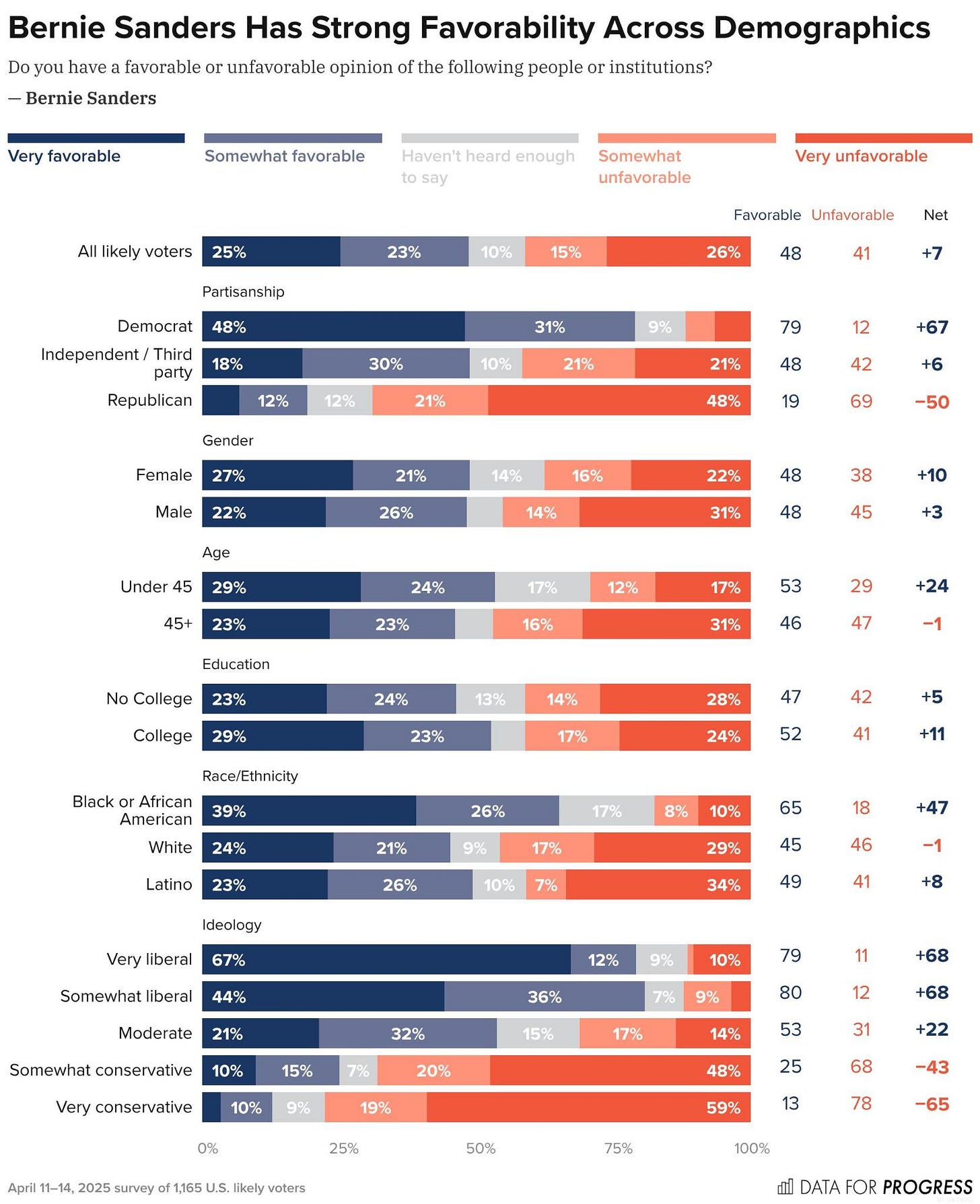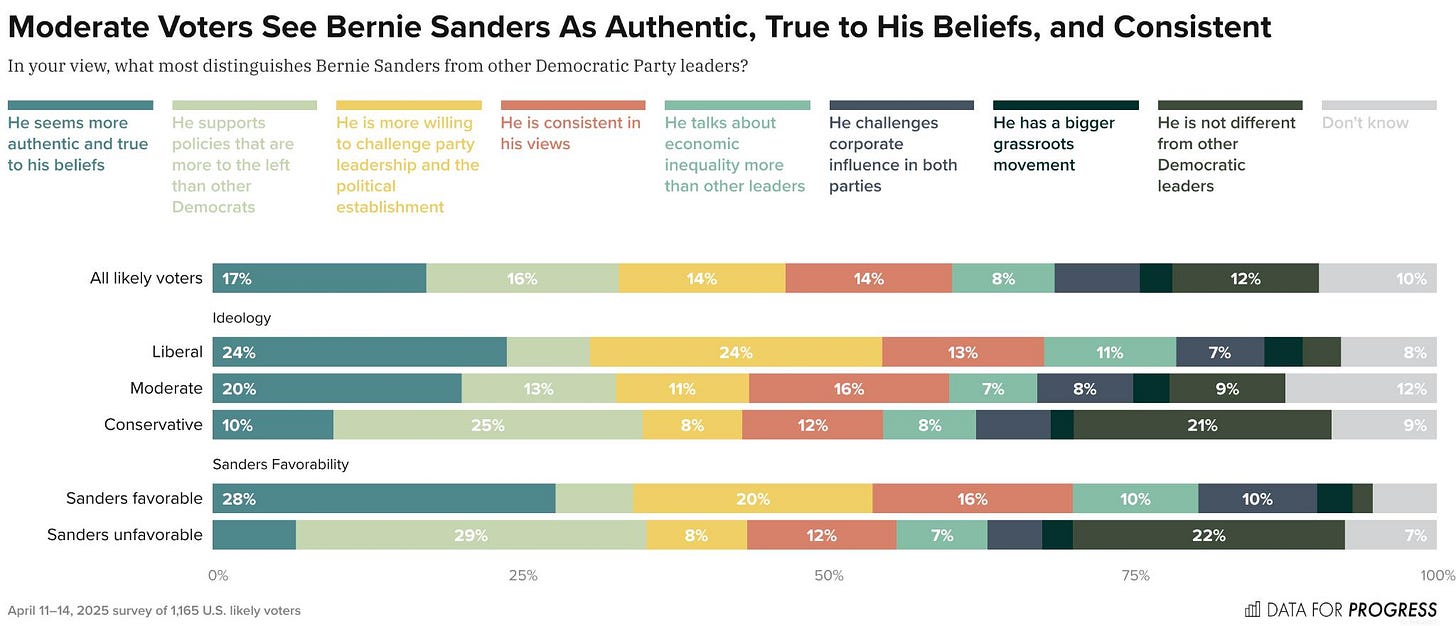EXCLUSIVE: Why Bernie Sanders is So Popular
A newly-released poll from Data for Progress shows why voters who otherwise dislike Democrats still approve of Vermont's socialist Senator.
When the 2024 election was called for Donald Trump last November, it meant more to liberals than just a single loss in one election cycle. Unlike the similarly narrow losses they faced as incumbents in 2000* and 2016, they had no popular outgoing president to take comfort in on their way out. Instead, they were forced to reckon with Joe Biden: the first Democratic president since Jimmy Carter to leave office with a net negative approval rating. For many of the party’s officials and the vast majority of its voters, this was the first truly failed liberal administration of their lifetimes—a fact that has put them in a position that they are completely unfamiliar with and unprepared for.
From here, liberal leaders and journalists have assumed that the anti-Trump movement is forced to start completely from scratch. All past ideas, they say, have been tried and failed; the past decade of politics only stands as a sunless space of endless failure. And at a glance, it can be very easy to get this exact impression. Even as Americans have soured on Trump 2.0, they still have very little love for his most visible opponents, whether they be leaders in Congress, his most recent foes at the ballot box, or the Democratic Party at large.
Proof of this can be found in a set of as-of-yet unreleased polling results from a Data for Progress national survey conducted from April 11th to 14th. Along with previously-published questions relating to energy and tax policy, Data for Progress also polled the favorability ratings of the Democratic Party and its leading national figures. These results have never been published until now. Ranked from best to worst, their findings were as such:
Former Vice President Kamala Harris: -1 net favorability (50-49 disapproval)
The Democratic Party: -8 net favorability (53-45 disapproval)
Former President Joe Biden: -15 net favorability (57-42 disapproval)
Senate Minority Leader Chuck Schumer: -16 net favorability (43-27 disapproval)
These results all correspond with the results found in similar national polls asking this question. They all match squarely within the overriding narrative about the Democratic Party as one that has squarely failed in the eyes of voters and needs to start entirely from scratch. But Data for Progress also polled the favorability ratings of a fifth Democratic-aligned politician—and the results for him were quite different.
Senator Bernie Sanders: +7 net favorability (48-41 approval)
Despite being the most visible national representative of the party’s radical wing, Bernie Sanders stands alone among the party’s national leaders in having net positive favorability among voters. This popularity doesn’t just make Sanders unique among politicians associated with the Democratic Party. While they weren’t included as part of Data for Progress’s survey, current polling averages show Donald Trump, JD Vance, Mike Johnson, John Thune and the Republican Party at large to have net negative favorability and approval ratings.
This makes Sanders not just the most popular national figure in elected office in the country, but the only national figure in elected office today to have a positive favorability rating, period.
As shown in the crosstabs above, Sanders’ popularity is both broad and deep, a result of both extensive support among core liberal constituencies and an ability to draw even with traditionally conservative demographics. He is more popular among women than men, yet has positive favorability with both genders. The same is true with college-educated and non-college voters; the former like him the most, yet the latter approve of him as well. Young voters approve of him overwhelmingly, as one might expect, yet he is also dead-even among older voters. White voters are the same, splitting 50/50 even as he wins broad approval among nonwhite voters.
Most strikingly of all, at least relative to media narratives, Sanders also enjoys broad approval among moderate voters, with a +22 rating that beat out all other Democrats surveyed. The overall picture is one of a politician who was sold short by even his own wing when they described him as one who could make up for alienating swing voters by boosting turnout among the base. To this day, Sanders’ true political strength is his capacity to accomplish both objectives in appealing to traditional swing voters and the left-wing base at the same time.
This, of course, isn’t breaking news by itself. Sanders’ broad popularity has been known for a decade now. The real question at hand is why it is the case—and it’s one that has had more than a few interpretations since his rise in 2016. To the left, it has been simply assumed that it is simply a result of his left-wing radicalism, and that his success proves that moving to the left will invariably be met with electoral benefits. The center, meanwhile, has worked tirelessly to frame his appeal as a result of anything other than his famous leftism, whether it be his past stray moderate stances or the magnetic charisma he brings as a scruffy octogenarian.
So, which side is right? Data for Progress tested exactly this, and they found that the answer is neither.
Above are the results of the first survey of its kind: a direct question towards voters as to what makes the uniquely popular Sanders stand out from the rest of the Democratic Party. The first thing worth noting here is that voters overwhelmingly regard Sanders as different from the rest of the Democratic Party in at least some capacity. Only 12% outright state that there is nothing that distinguishes him. The second is that his ideology, as defined by his support for policies to the left of other Democrats, is seen as distinguishing him by only a small number of voters who actually like him. Favorable voters are far more likely to distinguish him positively by bringing up his independence and authenticity.
The bottom two bars in the above graphic illustrate this dynamic clearly. Among the 41% of voters who dislike Sanders, a 51% majority of them say that he stands out for either being too left-wing or doesn’t stand out at all. Among the 48% of voters who like him, however, a combined 64% point to his either his authenticity, his willingness to challenge party leadership, or his consistency in his views as setting him apart. In comparison, only 6% of those favorable to him say that he stands out the most because of his left-wing ideology. Things are similar among moderates, whose broad approval of Sanders allows him to break even nationally. They, too, broadly see his authenticity and independence as distinguishing him the most, especially relative to his support of left-wing policies.
These results are consistent two things, both of which I have long argued in this newsletter. The first is that the anti-Trump resistance is not entirely in the wilderness. It does still have a working model for success; it’s just that that model does not involve the establishment staying in power. The second is that it is entirely possible for the left to be successful, but that the wing is always at its most effective when it focuses on its outsider status and sincerity as opposed to its abstract radicalism. This approach matches the successful strategy of Rashia Tlaib in 2024, who managed to be one of the rare few left-wing electoral overperformers that year after strongly denouncing her own party’s unpopular leaders. Put together, it only strengthens an already-robust body of evidence pointing towards candidate qualities and positioning relative to the establishment—not ideology in-and-of-itself—as the wing’s greatest strengths.
Of course, this would imply that the worst path forward for any left-wing candidate would be to max out on rhetorical radicalism while cozying up with the party establishment. You can make of that what you will.




Bernie favorable with a quarter of “somewhat conservative” voters is NUTS
Americans really do love a Maverick, huh? Too bad the wrong party learned that lesson